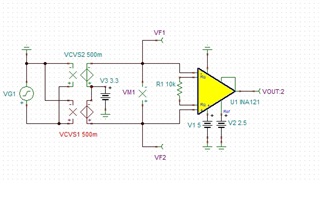I've seen a voltage controlled switch used in TINA-TI, to switch between two inputs to an INA, presumably in order to facilitate analysis of VCM vs Vout associated with the inverting and non-inverting inputs connected to a single source. I looked around to see if I could find a functional diagram which explains just how the source is switched between the two INA inputs.
Can someone point me to an article or source which explains how this switch is used, in terms of how often it switches, etc., basically how it works. I get the impression that in this context, the switch facilitates analysis of the behavior of the common mode voltage (CMVin) in relation to the area of linear operation of the INA by switching between the inverting and non-inverting inputs.
I'm including a Tina-TI screen of the circuit.
Thanks
Bob Edwards

